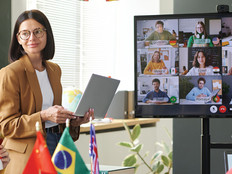Students Break Boundaries with Video Conferencing
Whether it’s a live pathology procedure or a discussion with a NASA astronaut, a classroom-based video conferencing initiative brings the world to students at the Massapequa Union Free School District in New York.
Massapequa deployed video conferencing to offer students opportunities that weren’t available onsite or through conventional field trips. “With video conferencing, we’re giving them a wide array of experiences,” says Robert Schilling, executive director for assessment, student data and technology services for the district.
Indeed, video conferencing has become essential in preparing students for college and the workforce, according to Alan Greenberg, senior analyst and partner with Wainhouse Research. “To ensure your students are ready for the technology they’ll experience in college, it’s invaluable,” Greenberg says. “On the job, employers expect workers to team across distances. Video conferencing helps students learn to collaborate effectively.”
Selecting a System
Massapequa Union Free School District purchased Polycom HDX 7000-series high-definition video conferencing systems to meet its teaching and learning goals. Each system includes an HD camera, microphone, interface box and remote control.
The district’s IT team selected the Polycom model for its reliability, high availability and conferencing quality. “The units are very stable and provide a crisp image with little or no noticeable video or audio lag,” Schilling says.
At the start of the 2009–2010 school year, the Massapequa district deployed video conferencing systems in nine school libraries and its central office. A projector and an interactive whiteboard with speakers round out the setup.
At three locations where space constraints made fixed mounts unfeasible, the district instead deployed LG Electronics 42-inch monitors with built-in speakers placed on Spectrum Flat Screen Carts.
The district fine-tuned its Cisco System switches and firewalls to deliver the quality of service required for seamless video conferencing. “When 25 students are taking time from their classroom [activities for a video conference] and you’re paying a NASA astronaut [to participate], you don’t want the system to freeze up,” Schilling says.
Building Usage
Professional development has been key to the initiative’s success, Schilling emphasizes. At the outset, the district gave each library media specialist his or her unit’s IP address and explained that they can think of it as a phone number — easy to memorize and use. “Then, we suggested they gain confidence by holding intra-district conferences, such as with high school students delivering content to elementary school students.”
The Board of Cooperative Educational Services (BOCES) of Nassau County also provides significant support. BOCES assists districts in the county with equipment selection, end-user training and conferencing administration, including an ever-expanding content catalog.
“Our catalog contains over 700 programs for this school year, almost double what was available last year,” says Patricia Iannacone, supervisor of distance education services.
At the project onset, Nassau BOCES loaned Massapequa a demo unit and facilitated a visit to another district that was already using video conferencing. Post-installation, the organization trained district administrators on the technology, Iannacone says.
SOURCE: “Taking the Wraps off Videoconferencing in the U.S. Classroom” (April 2009, Wainhouse Research)
By the end of the inaugural year, library media specialists and district administrators were fully confident with the system. During the 2010–2011 school year, interest took off. “We scheduled more than 100 conferences that year, including many from the BOCES catalog,” says Schilling.
While Massapequa anticipated students would embrace video conferencing, learning benefits went further than expected. “Interestingly enough, some of our most engaged participants are our struggling learners,” Schilling says.
More than 130 conferences have already been scheduled for the current school year, and Schilling expects the district to surpass last year’s totals.
“Live interaction provides a level of real-world experiences that aren’t readily available in a classroom,” Schilling says. “It’s really fascinating to watch.”
Tips for Video Conferencing Success
- Pick the right equipment. “Select industry-standard equipment to ensure interoperability for trouble-free conferencing,” says Alan Greenberg, senior analyst and partner with Wainhouse Research.
- Invest in professional development. “If building administrators experience video conferencing themselves, they’ll make conferencing happen in their classrooms,” says Patricia Iannacone, supervisor of distance education services of the Board of Cooperative Educational Services of Nassau County, N.Y.
- Leverage external resources. “We’ve conducted sessions sponsored by participants, such as with the author Jane Yolen, at no cost to us,” explains Robert Schilling, executive director for assessment, student data and technology services at Massapequa Union Free School District in Massapequa, N.Y.








